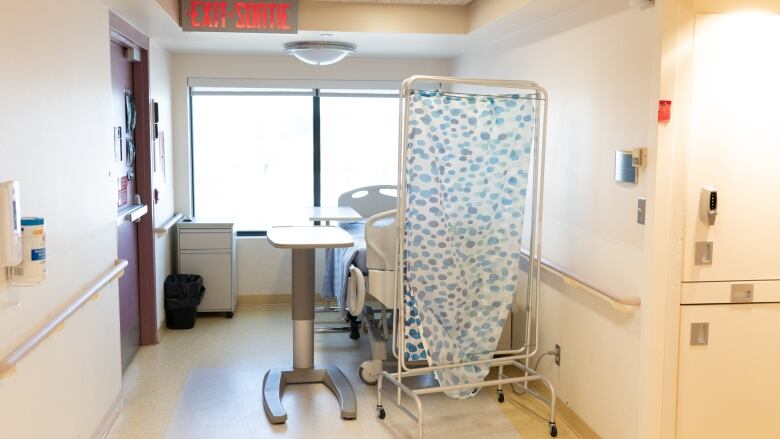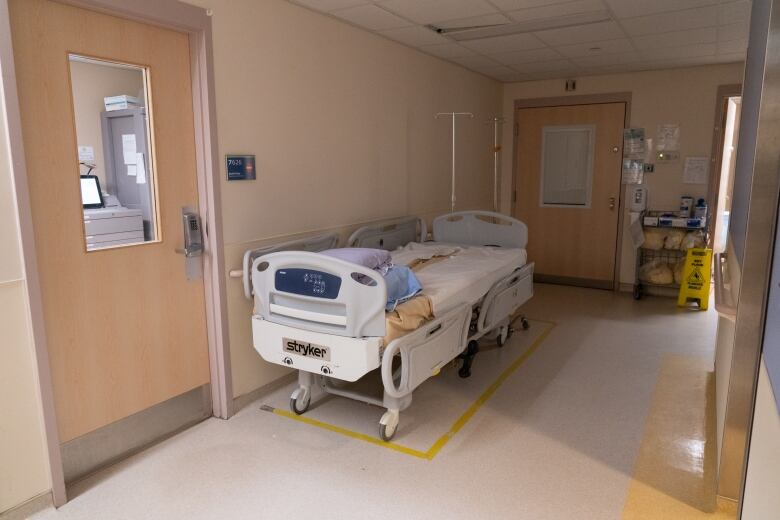Northeastern hospitals fight to keep 'hallway medicine' from being the new normal
Sudbury, Temiskaming and Timmins top list of over capacity hospitals in the northeast

There's a spot on the fourth floor of Health Sciences North, where the hall widens a bit.
It's now filled with a patient lying in a bed, just steps away from a bench where other patients are waiting to see a doctor and right next to the hallway where people are streaming past.
This patientis separated from this foot trafficonly by a few fabric privacy screens. The lights overhead stay on all night.
The Sudbury hospital also has a dozen patients in an open "dormitory" style room that used to be a rehab clinic for people recovering from hand surgery. This is meant to ease pressure during the annual flu season influx.
And then there's the 30 or so people who spend a day or more in the emergency department, waiting for a proper room to open up.
"It's not ideal," says vice-president of patient experience and digital transformation Mark Hartman.

Days northeastern hospitals were overcapacity in first 6 months of 2019
- Health Sciences North Sudbury 168
- Temiskaming Hospital 135
- Timmins and District General Hospital 72
- St. Joseph's Hospital Elliot Lake 54
- Sensenbrenner Hospital Kapuskasing 50
- North Bay Regional Health Centre 24
- Smooth Rock Falls Hospital 24
- Sault and Area Hospital 18
Health Sciences North has been dealing with this problem for the better part of a decade. The new Sudbury hospital was built too small and there is the chronic issue of the hospital housingseniors while they waitfor long-term care home spaces to open up.
But Hartman says they are focused on finding a fix, so it doesn't become the new normal.
"I'm not concerned that it will be accepted as an acceptable state to be in," he says.
"Working out how to solve that is not going to be an overnight fix."

Health Sciences North is moving its children treatment centre in order to free up space for another 56 beds and is encouraged by the province's pledge to invest millions in new nursing homes.
"It's not a simple problem, but it's great that the problem is being recognized across the province and hopefully that will lead to solutions," says Hartman.
A close second to Sudbury in hospital overcrowding is the Temiskaming Hospital, which was over capacity 135 days in the first six months of last year.

CEO Mike Baker says currently they are housing 67 patients in a hospital with 59 beds.
That means people staying in the chapel, in isolation rooms built for infectious disease outbreaks such as SARS and in the obstetrics unit, which is just supposed to be for new mothers and their babies.
Baker says on top of keeping hospital staff busier, those extra patients translate into more meals, medicine and cleaning, which has put the Temiskaming Hospital in a $1 million deficit position.
"So yeah, it's difficult to keep on top of it. It's difficult to find new solutions," he says.
Baker welcomes the province's plan for more long-term care homes, pointing out that a similar size community like Kirkland Lake has no overcrowding at its hospital, thanks to a shorter long-term care wait list.
But he says that could take years, during which seeing patients sleeping in hallways becomes more and more normal.
"Can the ministry keep up with the pace, while we're waiting for that other transition to happen?" says Baker.












_(720p).jpg)


 OFFICIAL HD MUSIC VIDEO.jpg)
.jpg)



























































































